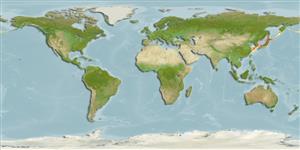Common names from other countries
Classification / Names / Names
ماع يماسا | فدارتم | Catalog of Fishes (gen., sp.) | ITIS | CoL | WoRMS
Environment: milieu / climate zone / depth range / distribution range
يسانش موب
; قمع تارييغت 0 - 80 m (Ref. 289). Subtropical
Northwest Pacific: Korea, Japan, and China.
Length at first maturity / Size / Weight / نس
Maturity: Lm ? range ? - ? cm Max length : 2.5 cm TL يسنج صاوخ نودب / رن سنج; (Ref. 283)
Body elongate, oval shaped; moderately elevated. Valve slate-blue, dark olive-grey or dark grayish brown with blotches of creamy white. Central areas minutely pitted in a chevron-like or quincuncial pattern. Lateral areas slightly raised, clearly marked; sculptured with flat, radiating costae. Girdle narrow; colored like the valves, sometimes with alternating bands of lighter and darker tones; covered with imbricating scales.
Occurs in stony bottoms and in oyster beds (Ref. 289); undersurfaces of stones and rocks (Ref. 1867). Found from intertidal to 80 m (Ref. 75835).
Life cycle and mating behavior
غولب | لثم دیلوت | یزیر مخت | اه مخت | Fecundity | )ورال ( دازوت
Members of the class Polyplacophora are mostly gonochoric. Life cycle: Eggs hatch into lecitotrophic planktonic trocophore larvae (no veliger stage) which later metamorphose and settle on the bottom as young adults.
یلصا ذخآم
عجارم | هدننك گنهامه | ناراكمه
Burghardt, G. and L. Burghardt. 2006. (Ref. 283)
NCUI زمرق تسرهف رد تيعضو (Ref. 130435)
ستياس رظن زا تيعضو (Ref. 108899)
Not Evaluated
Not Evaluated
اه ناسنا یارب رطخ
Harmless
یناسنا هدافتسا
| FishSource |
اهرازبا
رتشيب تاعالطا
Age/Sizeدشرنزو - لوطلوط - لوطيسانش تخير)ورال ( دازوتيناوارف
يتنرتنيا عبانم
Estimates based on models
Preferred temperature
(Ref.
115969): 10.2 - 23.9, mean 17.1 (based on 60 cells).
یريذپ بيسآ
Low vulnerability (10 of 100).
تميق هقبط
Unknown.
